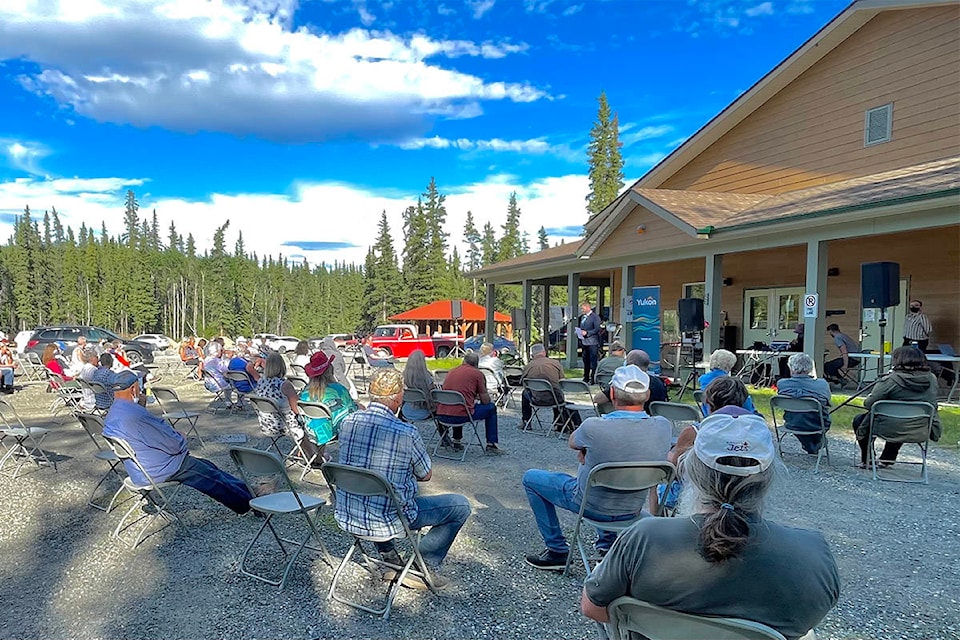A definite sense of concern permeated a meeting of Marsh Lake residents on June 29.
Over 50 people had come to hear the latest flood news from Yukon government officials. Those who already had water on their properties likely stayed home to address the multitude of tasks that needed to be done.
Most people listening had been around during the 2007 flood, and understood what was about to happen — anything from boat wakes, to south-blowing winds, to rain and more heat could accelerate property damage. Their nervousness was coupled with knowing that water can sneak around properties and come at a house from behind, avoiding sand bag berms and carefully laid out blockages.
Fourteen years ago may seem a long time for younger people, but for most present at the Marsh Lake Recreation Centre, 14 years ago was still vivid. Some were also feeling the reality of being 14 years older and having to deal with a physically exhausting event. Sandbags are heavy. Filling them by hand takes stamina. Piling them high requires even more strength and stamina.
This time, unlike last time, the Yukon government has been making better efforts to assist, with wildfire crews filling and distributing sand bags to properties where needed.
The Yukon government is relying on able homeowners to do mitigations on their properties and are utilizing the tremendous community effort of neighbours helping neighbours. They are building barriers called super bags and poly berms on Army Beach and are making a wave-wall at M’Clintock. Twenty dump trucks are running daily, and excavators are on different sites.
At the June 29 meeting, Kevin Lyso, director of emergency measures, prepared residents for the possibility of an evacuation alert or an evacuation order. He said residents could expect between one and 24 hours notice of an evacuation.
Two days later on Thursday evening, the government’s Incident Response team assessed over 140 Marsh Lake residences deemed under immediate threat.
“Some properties have already exceeded the 2007 high water mark. They are prioritizing the most at-risk properties and working from there,” said Echo Ross, an information officer with the emergency coordination centre.
The Yukon government and six newly arrived flood experts are still working to estimate the number of properties and primary residences “at risk” in the Southern Lakes area.
It was not just the early onset of high water, but it was also the rapidity of the water levels’ increase that alarmed most people. On Sunday and Monday, Marsh Lake levels were increasing by over 10 cm per day. On Wednesday, the rate slowed slightly to 8 cm, but the direction was still up.
Ross wrote that “the rate of inflow to Southern Lakes has started to slow down, but is still historically high. It will take a very long time until the inflow equals outflows.”
The system is still not balanced. By this time of year, Marsh, Tagish and Bennett are usually acting as one water body. This has not happened yet. There is still more melt coming into the system from mountain passes and basins than is flowing out through the Yukon River system.
The WhitePass mountain melt flows into Bennett, pushes water into and through Tagish and Marsh lakes, then struggles through the locks at the Marsh Lake dam, then onto Miles Canyon and Schwatka Lake.
As of Friday morning, crews at the lock gates were sandbagging to stave off erosion of the land that anchors the small Marsh Lake dam on the Yukon River. Erosion also threatens the road bank upstream between the locks and the rest stop.
Mila Milojevic, the vice-president resource planning and regulatory affairs at the Yukon Energy Corporation explained, “Inflows into Marsh Lake are the highest on record. They are about 25 per cent higher than the previous maximum record inflows and almost double the average inflows we would see in a normal year.”
Anthony Brier, a hydrologist with Water Resources added, “The current rapid increase is snow melt driven. Usually, it is rainfall driven in July, which is usually the wettest month. Given that we are seeing an event like we have never seen before, it is possible for levels to peak from snow melt events, then fall, then peak again from rain events later.”
As we all know, rain, like most weather forecasting, is nearly impossible to predict.
The short story is — water levels are high, they are going higher, they might drop down for a while, but high water will probably last a long time. Damien Burns of Protective Services reminded people that in 2007, equipment and incident command operators stayed in place until November.
A cool dry forecast might avert a summer of soggy and sodden ground, but no matter what happens, residents of perimeter properties on Marsh Lake are in for a long, tiring summer of heavy lifting and uncertainty.
Contact Lawrie Crawford at lawrie.crawford@yukon-news.com
